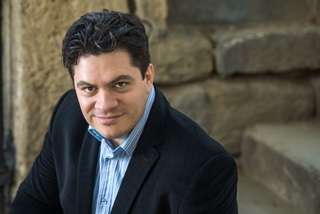|
Back
Măcelaru’s blood red Le Sacre Philadelphia
Verizon Hall
04/21/2016 - & April 22, 23*, 2016
Sergei Prokofiev: Symphony No. 1 in D major, Opus 25 “Classical”
Alberto Ginastera: Variaciones concertantes, Opus 23
Igor Stravinsky: The Rite of Spring
Philadelphia Orchestra, Cristian Măcelaru (conductor)

C. Măcelaru (© Courtesy of Philadelphia Orchestra)
Philadelphia Orchestra Conductor in Residence Cristian Măcelaru gamely helms cross-over orchestra events like “Cirque de la Symphonie” and he makes holiday concerts something musically more than might be expected, but it is great to see him on the podium with the Philadelphia Orchestra for regular programming. He has an affinity to less performed works and he also is a formidable interpreter of well trod repertory.
Măcelaru didn’t skip a beat making the most of a fine program of Prokofiev, Ginastera and, most mightily with Stravinsky’s The Rite of Spring that will not be forgotten by the April 23 audience in Verizon Hall.
Prokofiev’s Symphony No. 1 was the composer’s foray into more ‘assessable’ music than what he had been composing. Chunks of it were reprised by Prokofiev in his ballet score to Romeo and Juliet. Măcelaru fires it with a sense of intimate orchestra drama, with particularly rich full orchestral sonority and more rigorous tempos.
Ginastera’s Variaciones concertantes were performed with a reduced orchestra delivering that tight chamber music synergy. The fine opening cello and harp duet performed by John Koen and Elizabeth Hainen introduced a series of the concerto’s soloist passages framed by orchestral interludes for strings and flute, and some scorching brass. In program notes, Ginastera is quoted as giving the 1953 composition a “subjective Argentine character” rather than any expectation of indigenous folkloric music. It is a masterful synthesis of structural innovation and prismatic musicality featuring those 11 Variaciones mises en scène, all delivered with thrilling immediacy. Among the many standouts – Ricardo Morales (clarinet), Choon Jin-Chang (viola), John Bilger and Nitzan Haroz (trumpet and trombone), Jeffrey Khaner (flute) and bassist Harold Robinson. The concerto circles back to harp, again with the lustrous Hainen this time in a duet with bassist Harold Robinson.
The Ginastera work was a great warm up for Măcelaru’s blood red interpretation of Stravinsky’s Rite of Spring. In 2013 The Philadelphia Orchestra recorded The Rite in Verizon Hall with Yannick Nézet-Séguin conducting a completely sterling performance for Deutsch Grammophon as the centenary observance of its infamous premiere and subsequently and deservedly won a Grammy. Măcelaru’s interpretation is just as valid, and his interpretive difference from those performances and indeed most other conductors is felt right away. His is not the accumulation of its balletic plot that has suffered being trotted out too often as a concert showpiece and often too fixed in the audience’s mind to transcend its legend. Măcelaru rolls over that freight to unleash a pulsing, gorgeously primal musical beast it was meant to be.
There is no concussive vamp, for instance, in this performance and there is no time for conjuring memories of Nijinsky’s groundbreaking choreography. The Philadelphians unleash Le Sacre on its primal musical merits, and the force of it drives them instinctively. Meanwhile, Măcelaru is quite a show himself, at times like a bolt upright metronome maestro with lyrical expression down to his fingers or a panther pouncing at the ferociousness of the score as he rips his fist back for the off the cliff orchestral arrests.
The instantly trance-inducing bassoon of Daniel Matsukawa and oboists David Woodhams and Peter King summon the volcanic strings and the snaky voicings of the reeds and horns that can so often be off kilter in Le Sacre’s delicate chromatics, especially in the orchestral accelerations. Nothing seems, as so often the case, made exotic, instead Măcelaru, is inside the quantum velocity of Le Sacre that unleashes Stravinsky’s fully lucid and chaotic musical universe.
Lewis Whittington
|